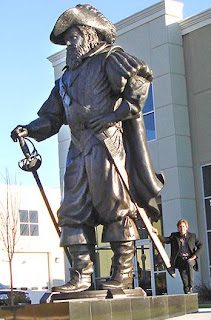 share. Some folks in Virginia are up in arms over a gigantic new statue of Christopher Newport at Christopher Newport University. It seems that the statue has one arm too many!
share. Some folks in Virginia are up in arms over a gigantic new statue of Christopher Newport at Christopher Newport University. It seems that the statue has one arm too many!Newport was the captain of the Susan Constant, the largest of the three ships that carried settlers to the death trap new colony at Jamestown in 1607. Like a lot of the early English explorers he was half-pirate on his mother's side, engaging in a long career as a privateer raiding Spanish galleons in the Caribbean. He was influential in establishing the Virginia colony, not only in its initial settlement but in several vital resupply efforts. His fourth voyage to Virginia went amiss when his flagship, the Sea Venture, began to leak and had to be run aground on Bermuda to prevent her from sinking. The loss of supplies led to the famous "starving time" at Jamestown. (The event also marks the initial colonization of Bermuda and served as the inspiration of Shakespeare's play The Tempest.) Newport eventually died on the Indonesian island of Java in 1617.
 It was during his privateer days that Newport lost his right arm in a fight with the Spanish in 1590. And yet the huge statue of Newport (presumably in 1607) shows him hale and hearty, with his right arm resting on his manly unsheathed sword. "We don't show our heroes maimed" was the explanation of sculptor Jon Hair (who from his website really does appear to be a bit of an ass). Local historians, not to mention disability advocates, are not amused. But at that point what could Hair say? "Ooops, I failed to do basic historic research on my topic before investing hundreds of hours and tens of thousands of dollars on my commission?" If Hair of anyone else in the project had so much as bothered to visit the Wikipedia page for Christopher Newport they would have been greeted with a illustration of the hook-armed explorer on a Virginia beach.
It was during his privateer days that Newport lost his right arm in a fight with the Spanish in 1590. And yet the huge statue of Newport (presumably in 1607) shows him hale and hearty, with his right arm resting on his manly unsheathed sword. "We don't show our heroes maimed" was the explanation of sculptor Jon Hair (who from his website really does appear to be a bit of an ass). Local historians, not to mention disability advocates, are not amused. But at that point what could Hair say? "Ooops, I failed to do basic historic research on my topic before investing hundreds of hours and tens of thousands of dollars on my commission?" If Hair of anyone else in the project had so much as bothered to visit the Wikipedia page for Christopher Newport they would have been greeted with a illustration of the hook-armed explorer on a Virginia beach.What is to be done? Probably nothing. The outstretched right arm is integral to the sculpture, it isn't likely they will lop it off for historical accuracy. My prediction is that they will put up a little disclaimer plaque in a discreet location: "Actually, this statue is completely wrong. Sorry."
Update: I started a thread about this over at the general interest website Metafilter where the users added some interesting twists to the story. This Washington Post editorial decries "a sanitized monument not only to the spirit of discovery and exploration but also to the liberties too easily taken with the past and the dead." Hair defends himself in this article in the Charlotte Observer, claiming "I have endeavored to be accurate in every historic piece I have sculpted." Another Metafilter member reminded us that statues of one-armed naval heroes are not uncommon, especially this guy.







